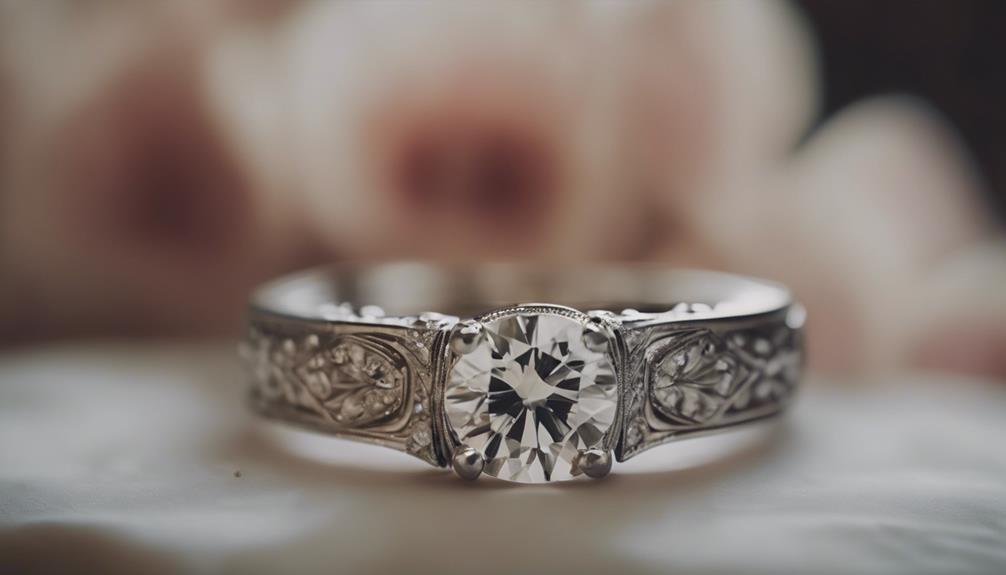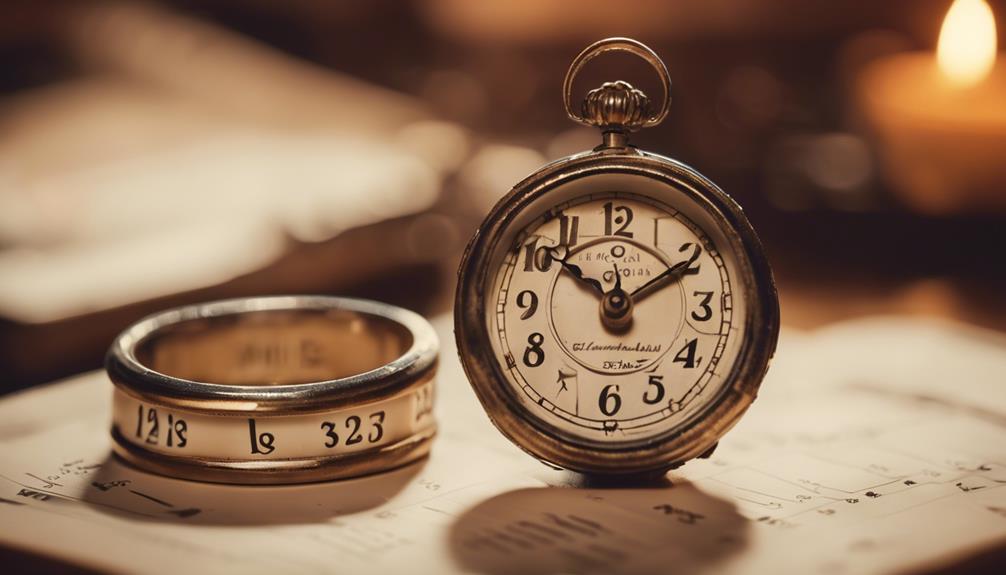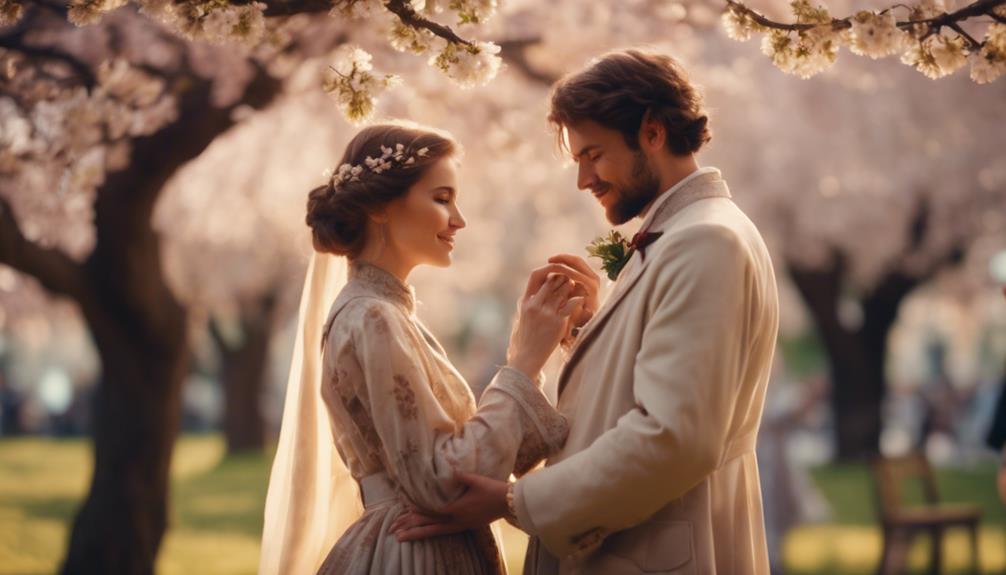People have been getting engaged since ancient times, with the tradition tracing back to the Romans and Egyptians. The earliest engagement rings, made from reeds or braided hair, symbolized eternal love. Romans later used iron bands to represent strength and permanence. Engagements were public declarations, allowing community input, and creating societal recognition. Religious practices like Jewish ‘erusin’ required a divorce to break an engagement. The first documented diamond ring was given in 1477 by Archduke Maximilian, sparking a trend for future engagements. Modern customs blend classic elements with personalization, reflecting evolving societal practices. There’s much more to discover about this tradition.
Historical Origins

The origins of engagement traditions can be traced back to ancient Roman times, where the exchange of rings began as a symbol of commitment. This practice signified a promise to enter into marriage, marking an important step in the betrothal process.
You might be surprised to learn that the earliest known exchange of engagement rings is actually attributed to the Egyptians, who believed that rings, often made from reeds or braided hair, bound the couple in eternal love and commitment.
In ancient Rome, the exchange of rings during a marriage proposal evolved into a formalized tradition. These rings were typically made of iron, signifying strength and permanence.
The concept of betrothal, rooted in Jewish law, further shaped Western engagement practices. Betrothal served as a formal agreement, often secured by the exchange of rings, which signified a couple’s mutual commitment.
During this period, engagement wasn’t just a private affair; it was a public declaration. It allowed for community counsel and even objections, ensuring that the commitment was acknowledged and accepted by the community.
Understanding these historical origins helps you appreciate the rich heritage behind the modern engagement and marriage proposal rituals.
Religious Practices
Religious practices surrounding engagements highlight the deep cultural and spiritual significance of this commitment. In Judaism, the engagement process, known as ‘erusin,’ is a formal betrothal ceremony. Historically, breaking this commitment required a divorce, underlining its serious and binding nature.
Christian traditions also place great importance on engagements. Many denominations incorporate engagement blessings into wedding ceremonies, marking betrothal as a sacred step toward marriage. In the Orthodox Church, specific rituals during engagement include the exchange of rings and the lighting of candles, symbolizing the couple’s commitment to each other.
Ancient Roman engagement rituals were influenced by legal customs. The giving of a ring signified a binding promise of marriage, a practice that eventually evolved into modern engagement customs. This legal significance underscored the commitment and societal acknowledgment of the betrothal.
Various religious customs emphasize the importance of family and community in the engagement process. In some cultures, matchmakers and parental consent play essential roles in marriage proposals, reinforcing the involvement of the broader community. These diverse practices reflect the spiritual depth and communal involvement that engagements represent across different faith traditions.
Evolution of Engagement Rings

Engagement rings have a rich history that dates back to ancient Rome, where they symbolized binding promises between partners. Initially, the rings were simple bands, often made of iron, signifying strength and permanence in betrothal agreements.
Over time, the tradition evolved, and by 1477, the first documented diamond ring was given by Archduke Maximilian to Mary of Burgundy, setting a trend that would shape future engagement customs.
In the 1800s, diamond engagement rings gained popularity in Europe and America. This shift reflected a growing emphasis on love and personal choice in marriage rather than arranged unions. The sparkling diamond ring became a symbol of enduring commitment and a promise of a shared future.
The tradition may have roots in bride price customs, where the ring represented both wealth and the seriousness of the marriage proposal.
The modern perception of engagement rings, particularly diamond rings, was heavily influenced by De Beers’ marketing campaign in 1947, with the iconic slogan ‘A Diamond is Forever.’ This campaign cemented the diamond engagement ring as a cultural standard for getting engaged, symbolizing eternal love and commitment in contemporary betrothal practices.
Modern Proposal Traditions
As engagement rings evolved into symbols of love and commitment, modern proposal traditions have also taken shape, reflecting contemporary values and romantic gestures. Today, wedding proposals are often elaborate and personalized events, showcasing the unique bond between the engaged couple. The practice of getting down on one knee remains popular, adding a touch of tradition to these modern moments.
Here are three key elements of modern proposal traditions:
- Surprise and Planning: While many couples discuss marriage beforehand, the exact timing and manner of the proposal are typically kept a surprise. This element of surprise adds excitement and emotional impact to the moment.
- Personalization: Modern proposals often include personalized touches that reflect the couple’s shared interests and experiences. Whether it’s a favorite location, a meaningful song, or a creative theme, the goal is to make the proposal memorable and special.
- Inclusivity: Contemporary society embraces diverse approaches to getting married. More women are proposing, and there’s growing acceptance of proposals in same-sex relationships, reflecting broader societal shifts towards equality and inclusivity.
These modern proposal traditions highlight the evolving nature of how couples celebrate their commitment to each other, blending classic elements with personalized, meaningful gestures.
Duration Before Marriage

Couples today often spend varying amounts of time dating before deciding to get engaged, ranging from a few months to several years. The duration before engagement can depend on numerous factors, including emotional readiness, social norms, and personal circumstances.
It’s not uncommon for couples to date for about 6 months to 3 years before taking the next step in their relationship. Surveys suggest that many individuals get engaged around the 8-month mark, though this isn’t a hard rule. The journey of commitment varies widely; some couples find themselves ready for marriage after dating for just a couple of months, while others may take years.
In fact, some relationships see partners dating for over a year before deciding to get engaged, showcasing the varying levels of commitment and readiness. There are instances where couples date for as long as 10 years before making the commitment to marry, emphasizing that the duration before engagement is highly individualized.
Whether it’s a brief courtship or a prolonged relationship, the path to marriage is unique for each couple. The key is finding the right moment that feels right for both partners, ensuring a strong foundation for their future together.
Conclusion
As you’ve explored, engagements have transformed from strategic family arrangements to personal commitments reflecting love and shared values.
You’ve seen how religious practices, the evolution of engagement rings, and modern proposal traditions have shaped this journey.
Whether couples date briefly or for years before getting engaged, the essence of an engagement remains a promise of a future together.
Understanding this rich history helps you appreciate the significance of this timeless tradition.



